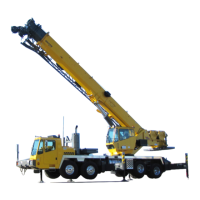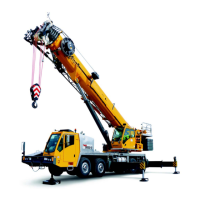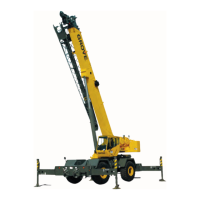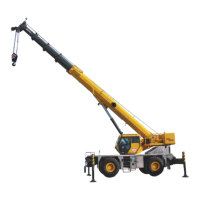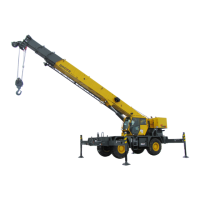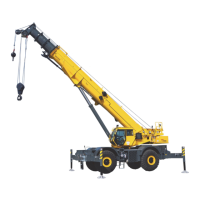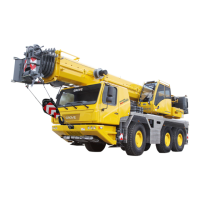2-47
TMS800E SERVICE MANUAL HYDRAULIC SYSTEM
Published 01-29-2014, Control # 496-00
ACCESSORY MANIFOLD WITH SWING
DIRECTIONAL CONTROL VALVE
Description
The accessory manifold with swing directional valve (see
Figure 2-33) is located on the right side of the turntable. The
manifold contains two adjustable pressure reducing valves,
five 3-way two position solenoid valves, 3-way four position
swing directional valve, and a check valve.
One pressure reducing valve provides 17.2 bar (250 psi) for
operation of the swing brake. The other provides 31 bar (450
psi) for the pilot circuit.
Each solenoid valve is held in its normally closed position by
a spring. When the solenoid is energized, the plunger
assembly forces the spool to shift, causing the valve to shift.
De-energizing the solenoid causes spring pressure to shift
the spool to its normally closed position.
One two position, three way solenoid valve serves as the
swing brake release valve. This normally closed valve, when
de-energized, prevents hydraulic oil pressure from releasing
the swing brake. When the swing brake switch is off, this
valve opens to allow hydraulic oil pressure to release the
swing brake.
One proportional two position, three way solenoid valve
actuated by the cab swing foot brake proportionally supplies
pressurized oil to the swing drive brake.
The three position four-way swing directional valve is
installed onto the manifold. Both swing working ports have
check valves that are flooded by a 4.1 bar (60 psi) resistance
check valve providing make-up oil to the swing motor for
motor over-run when the valve is centered. It receives oil
from pump #2 through swivel port 3. This section is
controlled by two proportional two position, three way
solenoid valves. These valves receive an electrical signal
from the cab armrest controllers.
Maintenance
Removal
1. Tag and disconnect the electrical connectors to the
manifold.
2. Tag and disconnect the hydraulic lines from the
manifold. Cap or plug the lines and ports.
3. Remove the bolts, spring lockwashers, and flatwashers
securing the manifold. Remove the manifold.
Installation
1. Install the manifold on turntable and secure with bolts,
flatwashers and spring lockwashers. Torque bolts refer
to Fasteners and Torque Values, page 1-13.
2. Connect the hydraulic lines to the manifold as tagged
during removal.
3. Connect the electrical connectors to the manifold as
tagged during removal.
Functional Check - Swing Brake Release Valve
1. Position the swing brake switch to off (push bottom of
switch). Verify the LED indicator in the front console
switch goes out.
2. Swing the turntable to verify the swing brake has
released. Step on the swing brake pedal to stop the
turntable.
3. Position the swing brake switch to ON (push top of
switch). Verify the LED indicator in the front console
switch comes on.
4. Activate swing and ensure the turntable will not rotate,
indicating the swing brake is on.
5. Check for leaks. Make repairs as needed.
Functional Check - Crane Function Control
1. Turn the crane function switch to OFF (push bottom of
switch).
2. Start the engine.
3. Try to telescope the boom in and out, lower and raise the
boom, hoist each hoist up and down, and swing the
turntable left and right. Verify none of these functions
work.
4. Turn the crane function switch to ON (push top of
switch), put the armrest down, and sit in the seat.
5. Telescope the boom in and out, lower and raise the
boom, hoist each hoist up and down, and swing the
turntable left and right. Verify all of these functions work.
6. Check for leaks. Make repairs as needed.
Inlet Filter Screen Replacement
NOTE: The filter screen should be replaced every 2000
hours or sooner under severe conditions.
1. Disconnect the inlet line from the P1 port on the valve
and remove the fitting from the port.
2. Remove hollow lock screw, spacer, and filter screen.
3. Install new filter screen, spacer, and hollow lock screw.
4. Install fitting in the P port and connect the inlet line.
Reference Only

